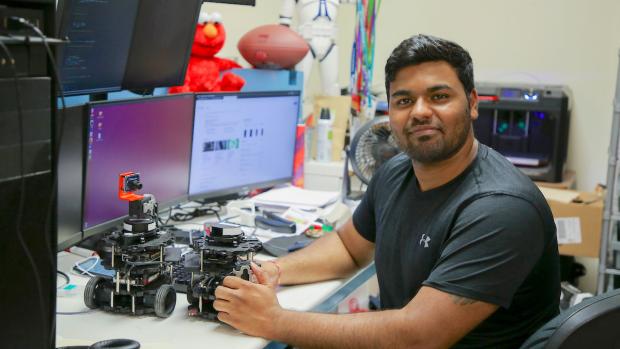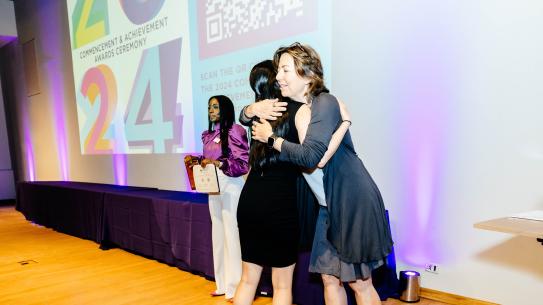Doctoral student explores the future of multi-robot systems in space

Sai Prasanth Krishnamoorthy, doctoral student in mechanical and aerospace engineering
NASA’s Mars Exploration rovers Spirit and Opportunity proved the vast capabilities of robots in hostile environments, including those far from Earth. But could there be a less costly, more efficient means of deploying robots to extraterrestrial realms that could also lower the risks involved with surface activities — such as terrain mapping — while eliminating the need for time-intensive human supervision from Earth?
The answer could lie with multi-robotic systems using so-called “swarm intelligence,” a form of artificial intelligence (AI) that focuses on the collective behavior of decentralized, self-organized systems. Sai Prasanth Krishnamoorthy, a doctoral student in mechanical and aerospace engineering at NYU Tandon, and one of the first students at NYU Tandon to earn his degree in the school’s mechatronics and robotics masters program, has found a route to swarm intelligence via blockchain-inspired ledgers that would allow teams of robots to divide and conquer, enabling them to perform such tasks as surface mapping on, say, Jupiter’s moon Titan, which is nearly an hour away from Earth at light speed, making human intervention in real time impossible.
Krishnamoorthy’s research, “Dark-Room Exchange: Human Supervision of Decentralized Multi-Robot Systems Using Distributed Ledgers and Network Mapping,” will be published in the proceedings of IEEE RO-MAN as part of the IEEE Conference on Robot and Human Interactive Communication this October in New Delhi, India. His work has implications for using spacefaring robots not as Han Solo-type loners, but as team players to collect and share information, and make micro-decisions when hazards arise.
A scenario might involve a fleet of autonomous robots on Mars on a survey/mapping mission in which they must split off alone or in smaller groups to explore different areas, requiring them to make several micro-decisions — based on knowledge such as battery strength, shared on a distributed ledger — which cannot possibly be controlled or coordinated by humans in real-time.
“Thus, without human intervention, the collective decision-making groups a robot with the lowest battery strength with two others. When the rovers meet, all mapping data and decisions, encoded on distributed ledgers, are merged based on blockchain time stamps,” Krishnamoorthy explained. “Hence, when these robots return to the base station, humans can access and review the ledgers and understand what maps and decisions were taken at what time and retrace the steps. This helps in understanding the integrated terrain map as well as what went wrong when something does go wrong.”
Also, if one robot is down or damaged in the process, the deficit doesn’t affect the system as a whole because all robots have the same information, shared through peer-to-peer communication, one robot passing on a piece of information to the others.
One feature of the research, which Krishnamoorthy performed in NYU Tandon’s Mechatronics, Controls, and Robotics Laboratory under the direction of Vikram Kapila, professor of mechanical and aerospace engineering, is a “dark-room exchange” (DRE) technique, wherein each robot in a team utilizes its on-board 2D LiDAR capabilities, peer-to-peer communication, and distributed ledgers to identify and track neighboring objects.
Explained Kapila, “When robots are deployed in unknown environments, whether here on Earth for disaster recovery or on space missions, for exploration and data gathering — map building is just one example — they should be able to collaborate amongst themselves, communicate and share information, and explore the area autonomously. Multi-robot/swarms are not only best suited to do this but they can also facilitate human robot collaborations. Ultimately, these systems will assist humans to effortlessly explore and establish settlements on alien worlds while reducing risk to their human counterparts," he said.
Krishnamoorthy, whose doctoral studies are supported under the NSF RET Site Award 1542286, is now working on the next phase — reinforcement machine learning, allowing robots to make unprogrammable decisions in real-time under the “observation, action, reward” paradigm.
Collaborators on Krishnamoorthy’s RO-MAN publication include Albert Go of the Massachusetts Institute of Technology, and Ashlee Tiwari of the Indian Institute of Technology, Kanpur, India, who served as summer research interns in the Mechatronics, Controls, and Robotics Laboratory.





